The hieroglyphics on the beach were obscure and alien.
Who could have created them? What did they mean?
I had heard of a fellow who raked labyrinths into the beach at Bandon, Oregon; to walk, to follow, to invoke a sense of meditation and peace. I’d even seen pictures. But these patterns were of a different style.
More geometric, less flowing, more lines and angles. Who could even freehand such perfect arcs and straight lines? Have the Nasca made a return on a smaller scale? Is this a beach bum’s version of crop circles?
I’ll never know. The tide erased the evidence, leaving a blank slate for another day.
I admit, when I came to Bandon I hoped that the resident maze master would have created a labyrinth for us to see and walk, if the tide had not already practiced it’s own form of meditation upon it. But that wasn’t the only reason.
I first encountered Bandon back in 1977, when I was exploring the western US for a new place to live. I was struck by the beauty of its beaches and always wanted to return. It only took 42 years to fulfill that wish.
The afternoon we were there was bright and sunny and very windy. Too bright, really, for good photography, the sun blue light peeked into every nook and cranny and created harsh shadows. And on that first vertical inch of beach, gangs of sand grains whipped along, abusing sandaled toes while the wind turned our ears into noisy wind tunnels.
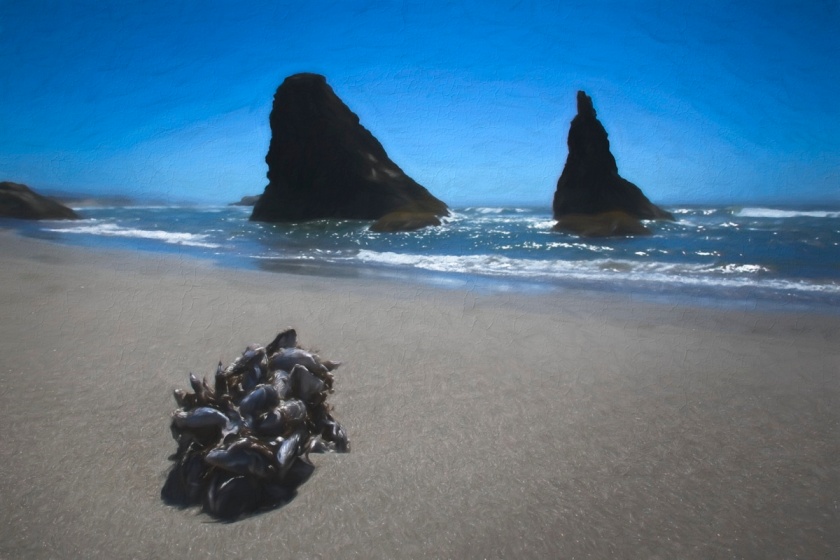
It was a nice view, but not super comfortable. We abandoned Bandon proper, and headed further south to the Bandon State Natural Area.
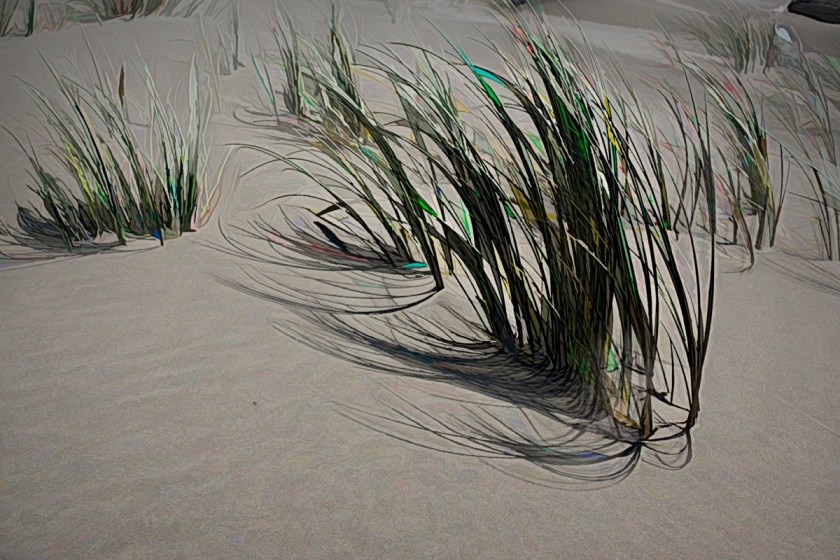
This turned out to be more beach and fewer people. It went further inland and provided grounds for beach grass and the last gasp for old trees.


How do things even grow on a beach? Even if a seed managed to not get blown away, how much nutrient can there be in salty sand?
Ok, ok, we spent time walking around the town center, and did the traditional, “we’re on the coast so we have to have the clam chowder or fish and chips” routine. Some folks take great pictures of small-town storefronts – I’ve never been that inspired by them. But there was something we encountered while walking along that was definitely out of the ordinary.
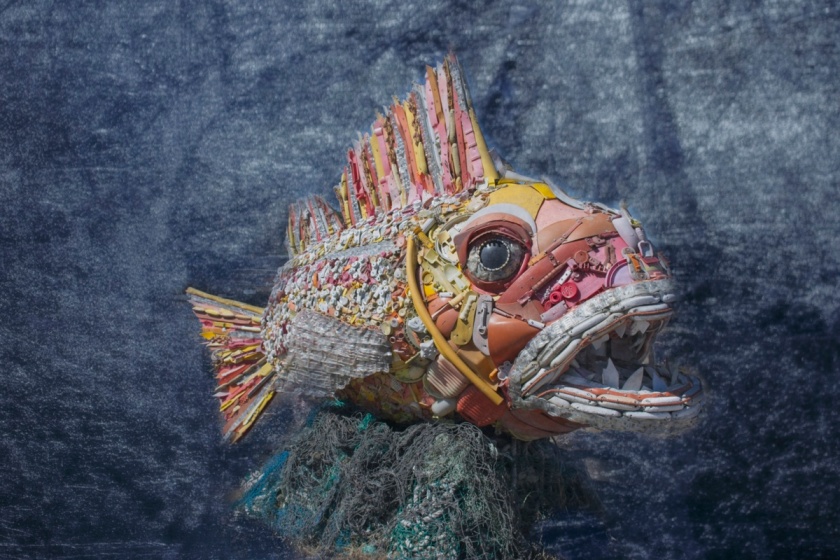
We found Henry in a non-descript place, swimming along in a clearing between a sidewalk and a parking lot, with ho-hum buildings in the background. Henry was not non-descript. Probably 15 feet long, he was a sculpture made entirely from trash picked up off the beach.
There’s an astonishing amount of trash that ends up on the beach. Some of it gets brought by tourists or locals, sloppy about cleaning up after themselves. Some comes from rivers, feeding the trash they pick up into their ocean terminus. Some is washed up from the ocean, coming from who knows where. Ocean currents have brought crap all the way from Japan. Not long ago an entire dock that washed loose in the Japanese tsunami washed up on Oregon shores, complete with its own ecosystem.
It’s common for Oregon coastal towns to support an artist population. Bandon has one that’s trying to make a difference, by converting trash picked up on local shores into sculptures, and using these sculptures to bring attention to the problem of plastic (and other) pollution in the oceans. It’s called Washed Ashore.

Beginning in 2010, Washed Ashore was founded by Angela Ponzi. With the help of a small dedicated staff and thousands of volunteers, they gather garbage off the coast and reshape it into various sculptures.
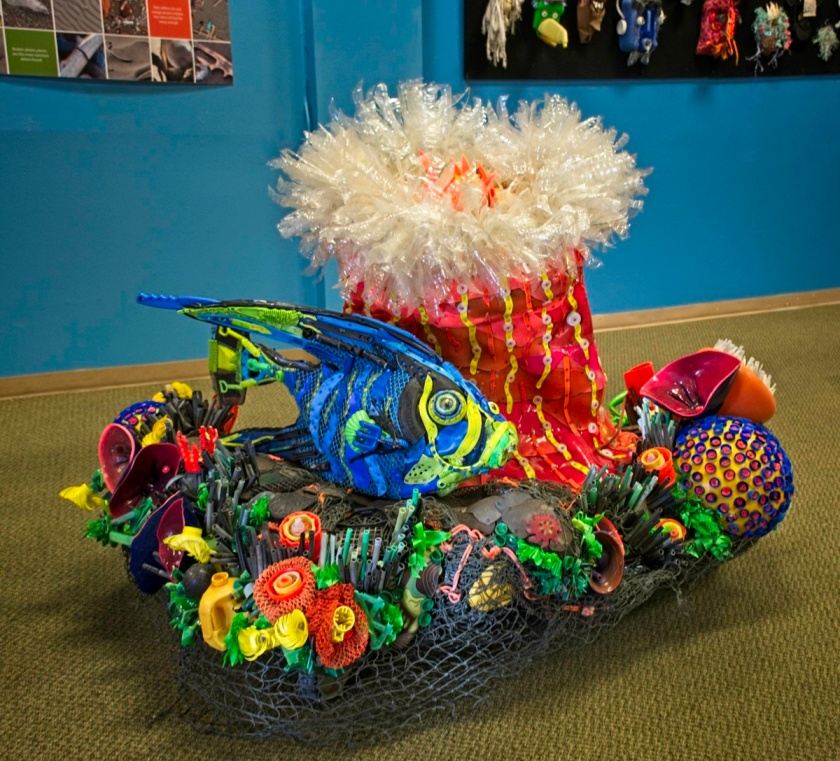
Since they’ve begun, they’ve collected over 19 tons of junk and created over 60 sculptures. Many of these sculptures travel the country to raise awareness of the problem, and to encourage folks to do their bit to reduce it.
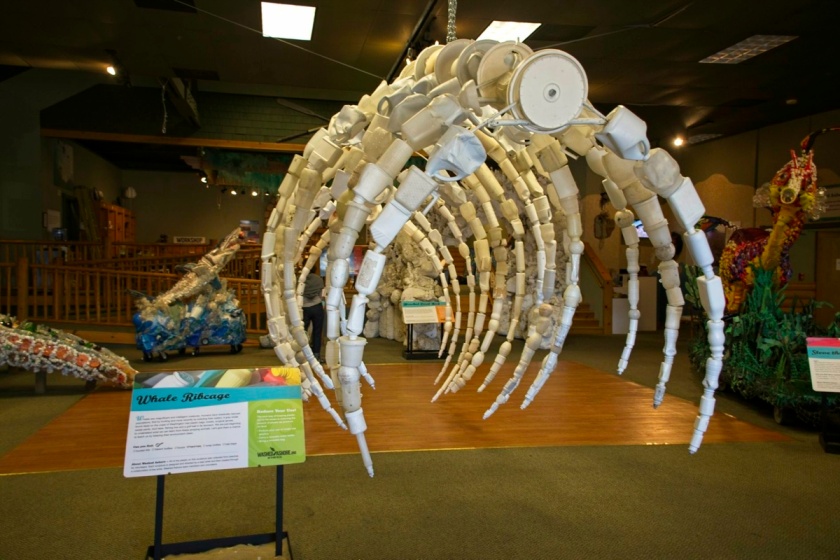
It’s not just plastics fouling the ocean. A dead whale washed up on the Washington coast had plastic bags, towels, sweat pants, surgical gloves, duct tape, and a golf ball found in its stomach.
Glass and other garbage show up as well, as the ill-fated whale demonstrated. Still, 90% of the garbage collected by Washed Ashore is petroleum based. 95% of it gets reused in the artwork.
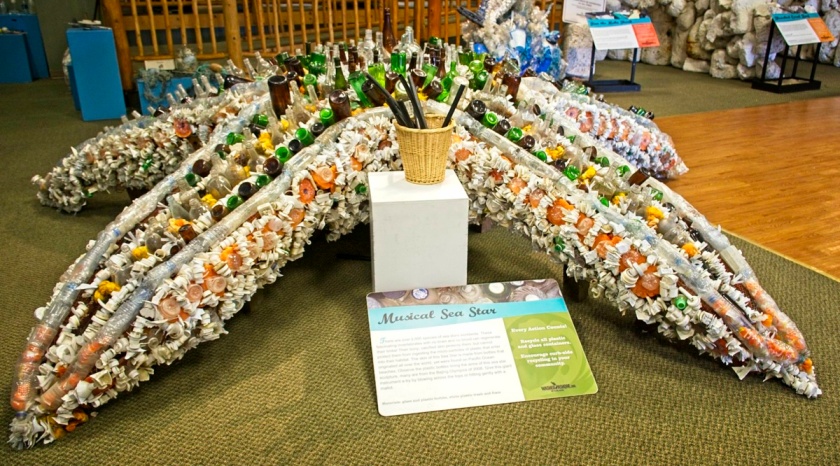
Plastics take a long time to break down. And even when they break down into microplastics, they can still affect smaller life – the bottom of the food chain.

What sort of thing goes into the sculptures? Plastic bags, bottles, shoes, lighters, bottle caps, nets, toys, toothbrushes, fake flowers, styrofoam, the list goes on. Feel free to click on any of these pictures and enlarge them to take a closer look.

Plastic bags are one of the biggest offenders. Often mistaken for sea jellies, these cause major problems for sea turtles and other creatures.
A Bandon Hope is that people will recognize the problems created by the throwaway society, by over packaging, by poor disposal methods and the lack of reuse.
And as for those who think this is just a snowflake liberal cause, that it doesn’t affect them or their children, that they’re free to use their rivers and oceans as a garbage dump; if this keeps up I have only one comment – and I speak as a scuba diver with a first-hand view of how the ocean is deteriorating.
Abandon hope. The Kraken of Time is coming for you.
For more information and more sculptures, see the Washed Ashore website.


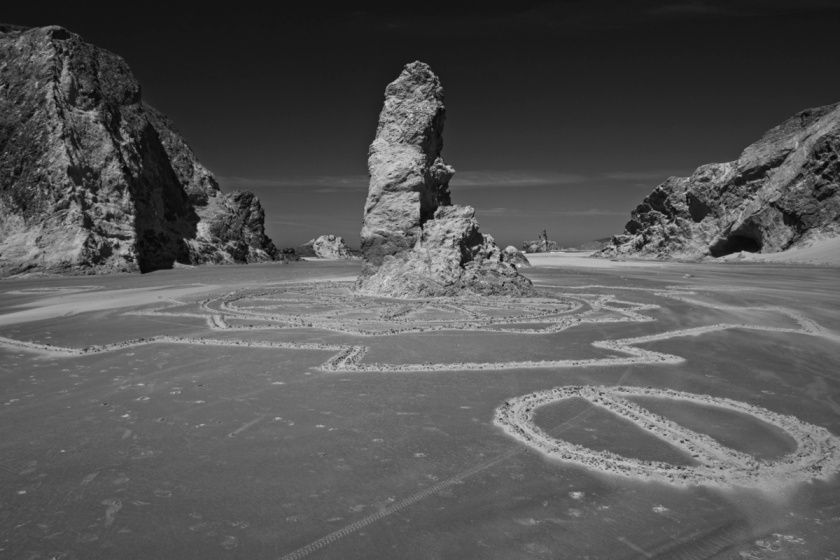
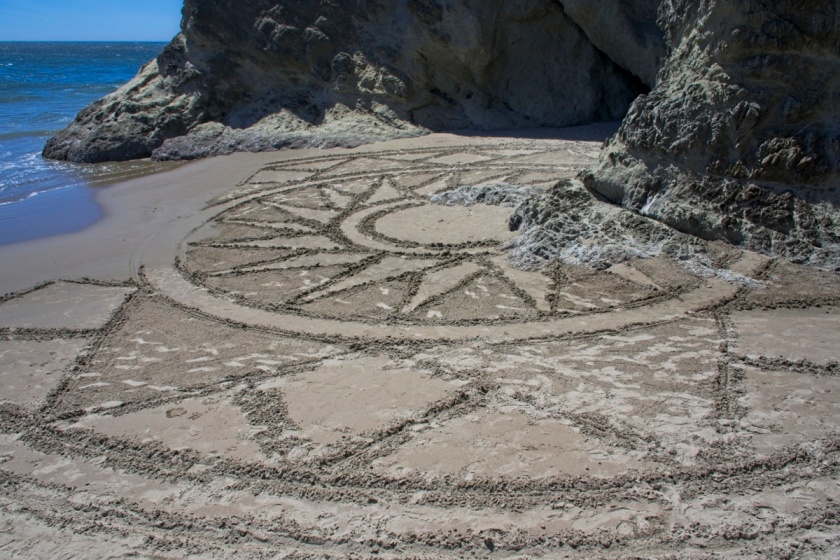


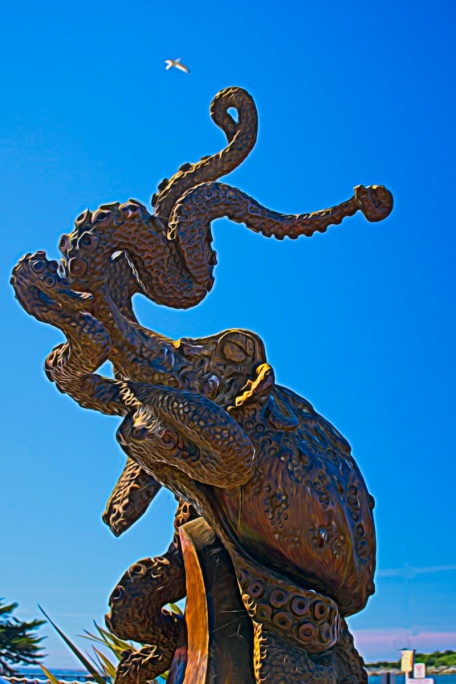
Great man-made and natural artwork at the beach, Dave!
LikeLiked by 1 person
Going to the beach is an art! 😉
LikeLiked by 1 person
That is the most beautiful trash I’ve ever seen. I’m not an ocean girl, but the trash we find in the Great Lakes is equally disturbing to me. We need to do better as humans.
LikeLiked by 1 person
They say one man’s trash is another man’s treasure, but I think they’re talking about garage sales and flea markets. In this case they’ve done more with less, and made art.
LikeLiked by 2 people
I often have mixed feelings about visitors leaving their mark on a place, but I think the beach rakings are a different category and more enjoyable as they are obviously of temporary nature. It is cool that litter is being used for sculptures. Encourages cleanup and creativity at the same time.
Very cl;ever title.
LikeLiked by 1 person
“Leave only footprints.” And even then when they’re not destructive.
LikeLiked by 1 person
We are phasing out plastic bags locally and, hopefully, prohibiting those plastic boxes (and similar) for takeout.
LikeLiked by 1 person
A lot of places are catching on. Still, sustainable/recyclable packaging is a ridiculous problem.
LikeLiked by 1 person
It is huge — buying from bulk foods is beneficial whenever possible.
LikeLiked by 1 person
Anything that draws attention to the Great Plastic Cataclysm is good, and you get artwork, too.
LikeLiked by 1 person
Sounds like a win-win.
LikeLiked by 1 person
West coast beaches are so appealing, and so very different from our local beaches. Your photos of the grasses and driftwood combined with sand are beautiful. Now that summer’s ending, it’s time to explore our own dunes and beaches farther south, where there’s more variety — and fewer tourists.
I smiled at your comment about plants growing on a beach, and your question: “how much nutrient can there be in salty sand?” Until the past couple of years, I didn’t realize how many plants in our salt marshes and on our beaches either tolerate salt or actually require it for survival. Too much fresh water, and some of them begin to languish pretty quickly.
A good bit of the trash on our beaches comes from the ships offshore. They give; we receive. A recent report gives some of the grisly details. I’ve found a few interesting items on beaches that clearly came from ships, including a wax voodoo figure that scared a Haitian friend to nearly to death, but most of it’s just trash, and most of that is plastic. It’s good to see it turned into art, but it would be better to see it eliminated. (Did you know that NOAA has a Marine Debris program? It’s worked with some great organizations in Texas and Louisiana.)
LikeLiked by 1 person
I didn’t even think about shipping. We have freighters coming across the ocean and up the Columbia River, who knows what they’ve lost overboard. I didn’t know about the Marine Debris program. You’re full of info. 🙂
LikeLiked by 1 person
‘Lost’ implies accidental. ‘Tossed’ often is more appropriate. If trash is dumped in international waters, the shipping companies can avoid regulations that apply within the 200 mile limit. And, of course, there are cruise ships, which present their own sort of problems.
LikeLike
This is a great post, Dave, I can’t believe the great stuff they’ve created out of junk. And I agree with Mick, it’s a great way to call attention to the quantities of crap we’re dumping into the sea.
I like the “paint effect” shots, they came out great!
I’d hesitate to walk into these elaborate sand patterns, mainly I wouldn’t want to mess them up, pretty cool, but also in case there’s a protective spell, or it triggers a Kraken attack, or I got tractor-beamed up to the mothership.
LikeLiked by 1 person
That’s it! Beach patterns are wormholes through space. How else could we explain all the weirdos on the planet?
LikeLiked by 1 person
👽
LikeLike
I was first struck by how this beach seems to be particularly special. I had to smile at your Nasca connection. I love the Washed Ashore creations. Simply extraordinary. Art has the ability to raise awareness so much more effectively than debates and preaching.
LikeLiked by 1 person
The Washed Ashore website has more of that art, and how it’s created. Maybe it takes visuals to make a point, it doesn’t politicize so easily.
LikeLiked by 1 person
As stewards of this planet, we are failing miserably.
LikeLiked by 1 person
Most folks don’t realise we’re stewards. We use and take for granted, much like eating ice cream and ignoring the cow.
LikeLiked by 1 person
It’s all impressive art, but I was especially impressed by the sand patterns! That took some time and talent. Once when we were on vacation, we would wake up each morning to a new sculpture down on the beach, of a very good quality. It was actually sad to see the tide wash them away.
LikeLiked by 1 person
The labyrinths I was hoping to see are even more elaborate. The creator of those has a twisted mind in a good way.
LikeLiked by 1 person
I love the junk sculptures for all kinds of reasons!
LikeLiked by 1 person
Not surprising; there are all kinds of reasons to love it. 🙂
LikeLike
I see, Dave, from your photos, that you were interested in almost everything in Bandon that interested us. I think I mentioned it’s one of my favorite Oregon coast towns. Peggy and I were headed that way this week, but the weather helped us decide to put it off to next week! –Curt
LikeLiked by 1 person
It seems like an interesting town, and I suspect there’s a lot I’m unaware of. Probably a good choice regarding the weather. It was pretty blustery up here last night, but we’re avoiding the worst of it.
LikeLike
Yeah, the weather here was on the ‘interesting’ side as well!
LikeLiked by 1 person
Fascinating post, Dave. I haven’t bought non-reusable/recyclable plastics in over a year, when I first learned of this issue with our oceans. I love hearing of organization like Washed Ashore. They tackle the problem with creativity – how brilliant!
By the way, I did the Google thing and saw the labyrinths of which you speak — they’re amazing!
LikeLiked by 1 person
Plastics are so pervasive they’re hard to avoid. Sounds like you’re doing your bit. Hopefully more folks can follow your lead.
LikeLiked by 1 person
Interesting, Dave. I only knew Bandon for its great golf courses. Now, I can also admire it as the Nazca of the northern hemisphere.
LikeLiked by 1 person
I’ve heard about the golf courses, but I think they’re out of my league. I wonder what the Nazca would do with a sand trap?
LikeLiked by 1 person
Long ago in another life, a colleague said “short-term prophecies as self-fulfilling; long-term prophecies are self-correcting.” I have often distorted that phrase to give myself hope for the future. I hope projects like Washed Ashore will succeed and cause an enlightened public to reduce/eliminate such waste in the future.
More broadly, at the time I heard that phrase, I was promoting “recycle everything we can and burn the rest for energy.” Environmentalists opposed the latter saying it would cause more pollution. In the 90’s, my current home Lee County Florida proved them wrong, recycles, produces significant amounts of electricity from waste, scrubbed the pollutants out of their stacks and has no landfills. We can reduce the use of plastic [e.g. in packaging], but there are too many benefits from plastics to eliminate them all together.
LikeLiked by 1 person
It’s a challenging problem, especially when there are so many that feel that profit trumps everything.
LikeLiked by 1 person
What a great place … I can see why you always wanted to go back. The patterns on the beach were a lucky find and made interesting photos too!
LikeLiked by 1 person
Maybe some day I’ll get to come back when the labyrinths are out. It’d be interesting to walking into one and shoot out.
LikeLike
Oregon has so many spectacular beaches….I know Bandon from Gunta’s photos – she is a master at capturing its moods. You made some really nice images, and it’s good to know about the Washed Ashore project, thank you. Henry the Fish and the Whale Ribcage need to spread the word far and wide!
https://gunta.photos/2015/07/19/bandon-sunset/
LikeLiked by 1 person
I checked out Gunta’s site. Too bad her Bandon page had a “minor disaster”, I’d like to see more.
LikeLiked by 1 person
I think she’s working on it – and I’m sure there will be more from time to time. Of course, the best “more” is going there! 😉
LikeLiked by 1 person
Artists are doing similar on this side of the Pacific. Hopefully the message gets through people.
That sand art is quite amazing to see. Even without the sand art, the seascapes are spectacular.
LikeLiked by 1 person
I’m sure the message is getting through to people, I’m just not sure it’s getting through to the right people. I suppose everyone can do their little bit, and hope cumulatively it makes a difference. Bandon is a lovely spot, but then most of the coast is.
LikeLike
What marvelous sculptures! Pity about all the trash though. 😢 Brandon looks to be a very dramatic beach.
LikeLiked by 1 person
I’m starting to see and hear of more and more legislation limiting plastic bags, straws, and things of that ilk. But over packaging is still a problem. I’d like to go back to Bandon for sunset on a nice night…
LikeLiked by 3 people
Ahhh Bandon… my first seaside love! I managed to tidy up the page with some favorite Bandon shots (eventually). There are so very, very many….
I’ve been working on putting together some favorites from the south section of our coast (where I now live and have the added advantage of being far closer to the sand), but it’s been a crazy, weird sort of year and I haven’t made much progress. I’ll have to keep working at it. 🤔
LikeLiked by 1 person
The Oregon coast has a lot of nice spots for sure. I hadn’t been to Bandon for something like 40 years, and that section of coastline was a big reason I wanted to do this particular trip.
LikeLiked by 1 person
Don’t tell anyone, but I find the actual South Coast (from Port Orford to the CA border) more to my liking. 😉
LikeLike
I suspect I’d have the same opinion if I’d explored it more.
LikeLike
🌊 Unfortunately there seems to be a lot of building going on lately. Hoping it doesn’t lose its less developed flavor anytime soon.
LikeLiked by 1 person